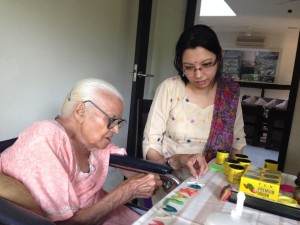Contact Us




Dementia as we know is a condition where the person exhibits a cluster of symptoms from problems with language, speech, memory to personality, behavior and mobility. Despite Dementia being a progressive condition, treatment has never been ‘curative’ in nature. It has always required a balance of both: pharmacological and non-pharmacological approaches, including use of behavior modification techniques for slowing down the progression of the disease.
Many researchers and doctors have admitted and agreed that the use of drugs/medications is primarily for managing the condition. Creative Arts therapy is a fresh perspective and is slowly establishing itself as a strong influence for Dementia patients.
Music and Arts have been a huge part of our culturally rich and diverse Indian history. Some of its benefits are as follows:
1) It has a soothing positive effect on individuals and has been credited as a beautiful form of self-expression.
2) It focuses on the existing strengths of the individual, thereby looking beyond the disease of the person.
3) Social withdrawal or disengagement from the society is one of the key behavioral changes noted among the individuals diagnosed with dementia. Incorporating activities around Music and Art helps them to open up and connect back to the society.
4) Music and Art therapy provide an outlet for dementia patients with language and speech difficulties to express and share their feelings, thus providing a medium of communication.
5) With Dementia, there is a progressive decline observed in these sense organs, thereby causing difficulty to understand and connect with the world around. Engaging in different art and craft related activities involving use of different colors and textures can stimulate their senses.
6) Increased concentration, socialization, self-esteem, alertness and evoking positive feelings are some of the other significant benefits of the same.
7) Music can be a pleasant distraction and helps in managing certain difficult behavior such as agitation, aggression, pacing etc.
8) Different forms of music can awaken different memories, thereby helping them with reminiscence: going back in time and reliving good moments.
For one of my clients, who is an FTD patient, music is a way to calm her down, when she is anxious. It comforts her and makes her happy. Listening to old songs, singing along and talking about them for many is a way to feel good and positive, thereby contributing to their overall well-being. They tend ring in memories from the past of the person, thereby acting as a way to interact with the society.
A client of mine, who is a stroke patient, finds art as a way to express herself. She paints often, and now keeps a small collection of her paintings in her room. She had learnt painting in her younger days, and engaging in her hobby makes her feel confident and assures her that she is still productive, thereby adding a sense of meaning in her life.
Music and Art has always been therapeutic. Application of music and art therapy for helping dementia patients has shown impressive results abroad. More importantly, it has given a new ray of hope for many family members: to see their loved ones smile and enjoy their lives despite the roadblocks posed by the illness.
We at Samvedna Care aim to help seniors live happy, active and independent lives, in the comfort of their home and community through interactive caregiving.
Samvedna Care was established in October 2013 with two complementary goals – firstly to provide quality home care services to seniors with limited mobility and social interaction due to various constraints, and secondly to facilitate stimulating community interaction and participation.
Our Dementia Care services are –